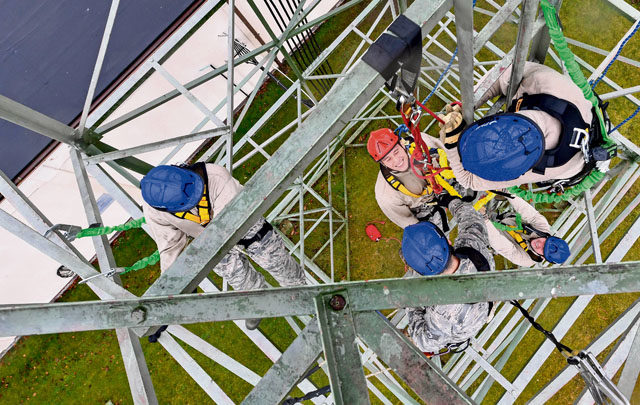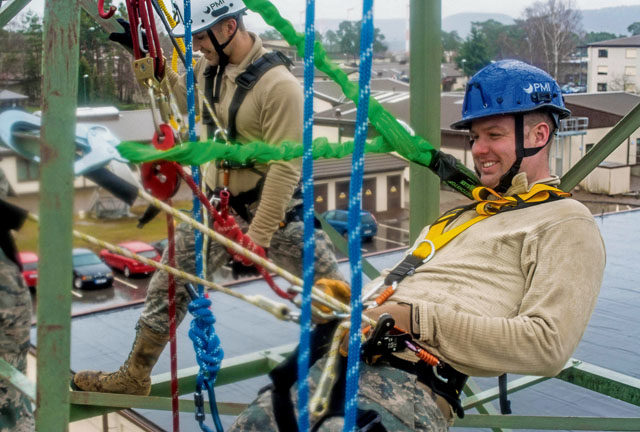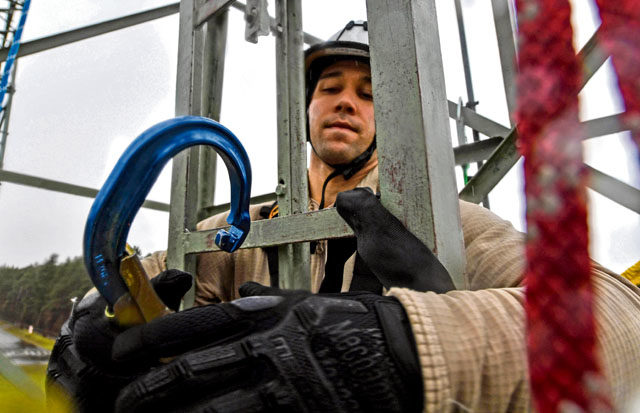
The sound of clinking harnesses filled the air as the Airmen toiled ever upward toward the clouds. Fat raindrops, too impatient to wait, leapt down to meet them and dripped off boots, hard hats, and gear. Far above the ground the Airmen focused on the task at hand, momentarily oblivious to those below them and the vast expanse of space in between.
Six 1st Communications Maintenance Squadron Airmen participated in Tower Rescue and Climbing Training March 9, obtaining heights of approximately 50 feet to receive their certification.
The 1 CMXS is in the only squadron within U.S. Air Forces in Europe capable of certifying Airmen in the course.
“This training has to be done once a year in order to be a climber,” said Staff Sgt. Abraham Pulido, 1 CMXS cable and antenna maintenance technician and lead trainer for the course. “In order to be a climber, you have to know how to rescue people. You never know when someone could get hurt and you have to rescue them.”
The rescue technique taught during the training was the basic form of rescue and one that could be accomplished by a single person.
“The training we taught today was geared toward working with someone who got hurt and you didn’t have anybody else to help you,” Pulido said. “You can pull the victim up, undo their equipment, and rescue them by yourself.”
Despite the continuing rain and chilling breeze whirling through the tower, the Airmen took turns rescuing and playing a simulated victim.
”The most difficult part was the rain, without a doubt,” said Staff Sgt. Ehren Brown, 1 CMXS unit deployment manager and student in the course. “Sometimes you have to work in the rain. It creates a hazard, so you try to avoid climbing while it’s raining, but sometimes you just have to do it.”
With soaked-through gloves the victims were attached to an individual descender (ID) cable, along with an additional rope for safety purposes during the training. Their two pelican hooks, which are used to secure Airmen to towers while they climb, were removed from the tower and secured to their harness. Slowly, the rescuer lowered the victim to the soggy ground below.
“This training is very important,” Brown said. “When somebody’s hanging there, their blood doesn’t circulate properly, so if they hang too long it can actually kill them. This training is essential for getting people down as quickly as possible.
“I’ve been out of my career field for two years as a UDM,” he continued. “It would have taken me far longer to set up the ID rope, and the person would have been at more risk had I not been able to do this training today.”
After the final victim was safely delivered to the bottom of the tower, those who still remained above slowly worked their way down the slick metal back to earth.
While the majority of the training focused on the rescue aspect, it also provided a refresher for climbing towers in general.
“I do enjoy climbing,” Brown said. “It’s been awhile since I’ve been able to do it, so I was really glad to have the opportunity to come out here. Lowering people is definitely my favorite part.”
Anyone who was a first-time climber was required to undergo the “scared of heights” test. It consisted of leaning all the way back from the tower and removing one foot at a time while touching their nose. The purpose of the test was to get the Airman comfortable with relying on their gear to prevent them from falling.
“I hope the students learned safety comes first, but also that when they’re working aloft, it’s very easy to forget you’re at a high elevation,” Pulido said. “This teaches the importance of knowing where you’re anchoring and your basic climbing knowledge.
“I think everyone in our career field should do this at least once a year because you never know when you might be tasked to go downrange or on a temporary duty and have to climb a tower,” he continued. “In a real-world scenario, we would have done exactly what we did today.”
Even with their heads in the clouds, the 1 CMXS Airmen remained sharp and focused to safely complete their tower rescue and climbing training.




